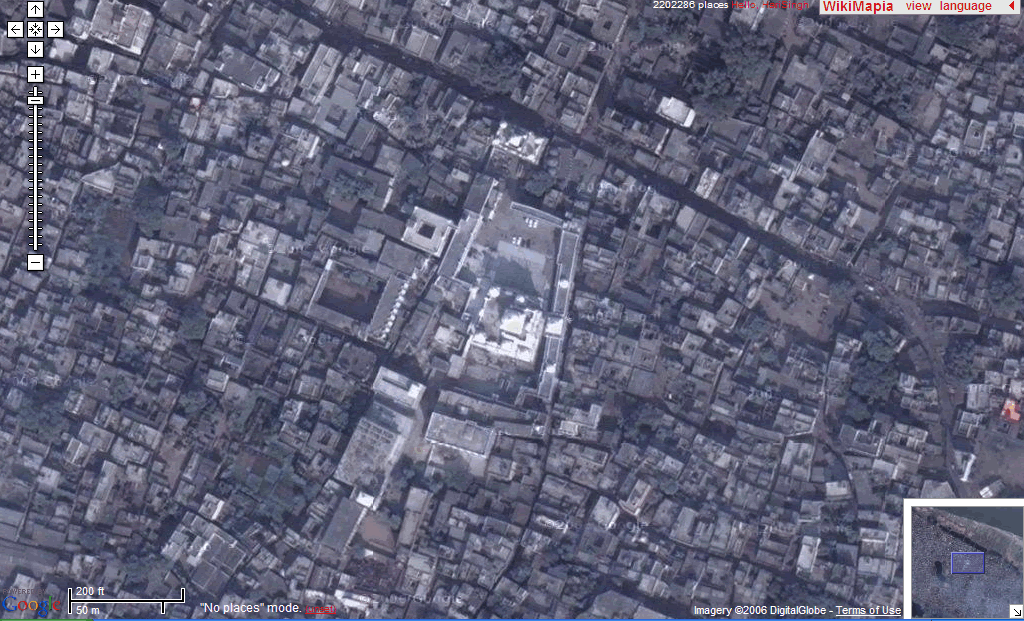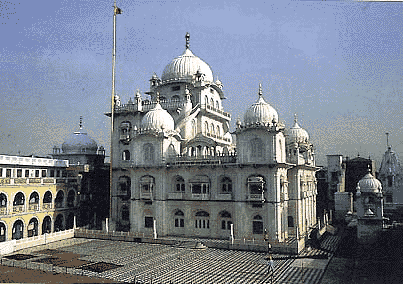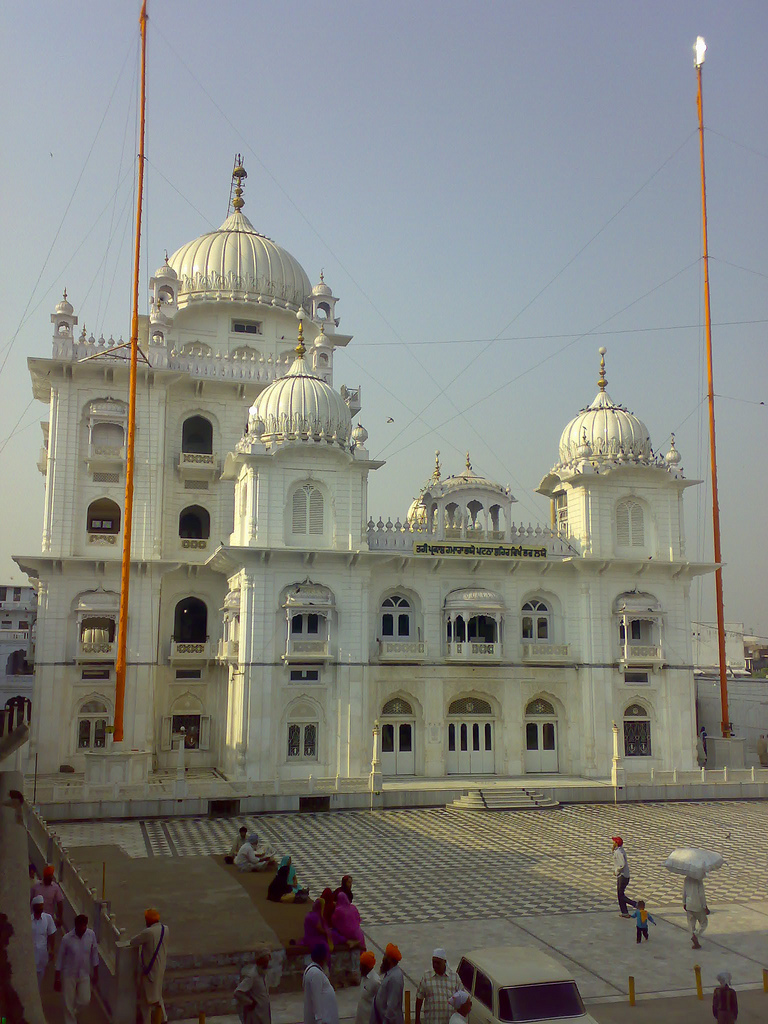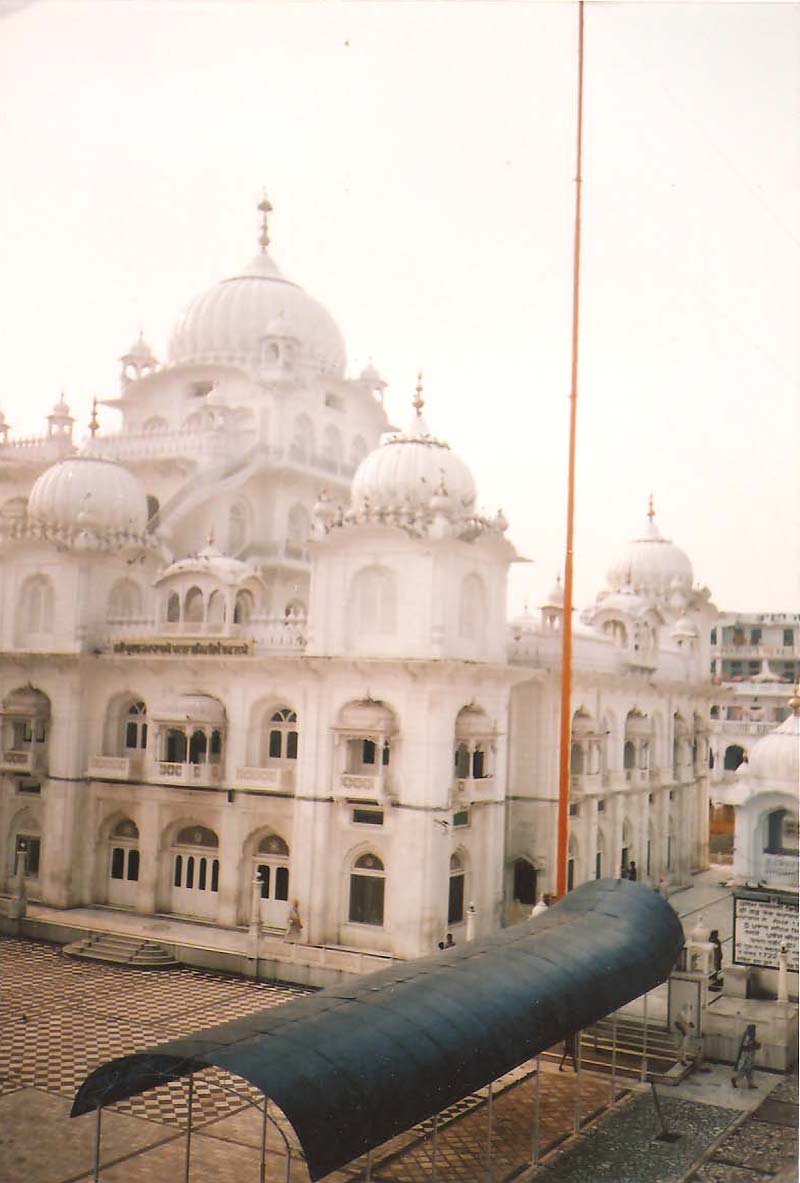Takhat Sachkhand Sri Patna Sahib
It was here at Takhat Patna Sahib, that Guru Gobind Singh, the tenth Sikh Guru was born in 1666. He also spent his early years here before moving to Anandpur. Besides being the birthplace of Guru Gobind Singh, Patna was also honored by visits from Guru Nanak as well as Guru Tegh Bahadur.
This is one of only five Takhats or Seats of Authority of the Sikhs. The Gurdwara Patna Sahib is in remembrance of the birthplace of Guru Gobind Singh, the tenth Guru of the Sikhs. Like many historical Gurdwara's in India and Pakistan, this Gurdwara was built by Maharaja Ranjit Singh.
Originally, at this place stood the haveli of Salis Rai Jouri, who was a great devotee of Guru Nanak. He was so much influenced by the teachings of the Guru that he converted his palatial home into a dharamsala (place where dharam is learned).
Guru Tegh Bahadur visits Patna
When Guru Tegh Bahadur visited Patna, he stayed in this exact site. A magnificent house was built above the dharamsala of Salis Rai. Mullah Ahmed Bukhari, the author of Mirat-ul-Ahwal Jahan Nama, who stayed at Patna for some time at the close of 18th century, has made a reference to Harmandir Sahib. He writes, "Over the birthplace of Guru Gobind Singh, the Sikhs have raised a public edifice, made it a place of power and strength, and call it 'Harmandir'. It is also called 'Sangat' and is held in great esteem and veneration. They have made it a place of pilgrimage. Maharaja Ranjit Singh started the work of reconstructing the Harmandir in 1839 following destruction by fire, but did not survive to see the new structure. Again in 1934, when an earthquake rocked the entire state of Bihar, some portions of the Harmandir fell down. Construction of the present building was taken up on November 19, 1954 and was completed in about three years.
The other four Sikh Takhats are:
- Akal Takhat in Amritsar (beside the Golden Temple)
- Takhat Keshghar Sahib in Anandpur Sahib (Birthplace of the Khalsa)
- Takhat Damdama Sahib (in Batinda district of Panjab)
- Takhat Sachkhand in Hazur Sahib (the place where Guru Gobind Singh took his last breath)
Gurdwara Patna Sahib

"As described by Charles Wilkins" By Professor Kirpal Singh, Punjabi University
Charles Wilkins was one of the pioneering orientalists of the 18th century. With his help Sir William Jones, founder of the Asiatic Society, Calcutta, learned Sanskrit. Later, he earned the title of "Father of Sanskrit" in the eyes of his contemporaries by writing a grammar of the Sanskrit language. He was the first to design and manufacture the type for production of Sanskrit and Persian grammars and proved to be a pioneer in the typographic art in the oriental language.
Born in 1749 in England, Wilkins joined the service of the East India Company at the age of twenty. He made the suggestion to the Governor General, Warren Hastings, to establish a printing press in 1778. Wilkins translated the Manusmriti, Mahabharat and Hitopdesh and the later years of his life were devoted to the revision of Richardson's Persian, Arabic and English Dictionary. He died in 1836 in England.
Charles Wilkins was one of the earliest Europeans to write about the Sikhs. He wrote on March 1, 1781:
"Before I left Calcutta a gentleman with whom I chanced to be discoursing of that sect of people who are distinguished from worshippers of Brahm and followers of Mohamed by the appellation 'Seek' (meaning Sikhs) informed me that there was a considerable number of them settled in the city of Patna."
Since he was proceeding on leave to Benaras he stopped at Patna. Following is the description of Gurdwara Patna Sahib and the daily routine there:
" I found the College of the Seeks (Sikhs) situated in one of the narrow streets of Patna, at no very considerable distance from the custom house. I was permitted to enter the outward gate; but as soon as I came to the steps, which led up into the Chapel, or public hall, I was civilly accosted by two of the Society; I asked them if I might ascent into the hall. They said it was a place of worship open to me and to all men; but at the same time, intimated that I must take off my shoes…I did not hesitate to comply, and I was then politely conducted into the hall, and seated upon a carpet, in the midst of the assembly, which was so numerous as almost to fill the room.
The Congregation
The congregation arranged themselves upon the carpet, on each side of the hall, so as to leave a space before the altar from end to end. The great book, was brought, with some little ceremony from the altar, and placed at the opposite extremity of the hall. An old man, with a revered silver beard, kneeled down before the desk with his face towards the altar; and on one side of him sat a man with a small drum, and two or three with cymbals. The book was now opened and the old man began to chant to the tune of the drum and cymbals; and, at the conclusion of every verse, most of the congregation joined chorus in a response, with countenances exhibiting great marks of joy. Their tones were by no means harsh; the time was quick; and I learnt that the subject was Hymn in praise of the unity, the omnipresence and the omnipotence, of the Deity.
I was singularly delighted by the gestures of the old man; I never saw a countenance so expressive of infelt joy, whilst he turned about from one to another, as it were, be speaking their assets to those truths, which his very soul seemed to be engaged in chanting forth. The Hymn being concluded, which consisted of about twenty verses, the whole congregation got up, and presented their faces with joined hands towards the altar, in the attitude of prayer. A young man now stood forth; and, with a loud voice and distinct accent, solemnly pronounced a long prayer, or kind of liturgy, at certain periods of which all the people joined in a general response, saying Wa Gooroo. They prayed against temptation; for grace to do good; for the general good of mankind; and a particular blessings to the Seeks; and for the safety of those who at that time were on their travels. This prayer was followed by a short blessing from the old man, and an invitation to the assembly to partake of a friendly feast. The book was then closed and restored to its place at the altar.
The Holy Pudding
The two men entered bearing a large iron cauldron, called a "curray", just taken from the fire, and placed it in the centre of the hall upon a low stool. These were followed by others with five or six dishes, some of which were silver, and a large pile of leaves sewed together with fibres, in the form of plates. One of these plates was given to each of the company without distinction; and the dishes being filled from the cauldron, their contents were served out until everyone had got his share. Myself was not forgotten; and, as I was resolved not to give them the smallest occasion for offence, I ate up my portion. It was a kind of sweetmeat, of the consistence of soft brown sugar, composed of flour and sugar mixed up with clarified butter, which is called "ghee". Had not the ghee been rancid, I should have relished it better. We were next served with a few sugarplums and here ended the feast and the ceremonies of the day. They told me the religious part of the ceremony was daily repeated five times.
Sikh Tenets
In the course of the conversation I was engaged in with the two Seeks before the service, I was able to gather the following circumstances. That the founder of their faith was called Naneek Sah, who flourished about four hundred years ago at Punjab, and who before his apostasy, was a Hindoo of the Kashetry, or military tribe; and that his body disappeared as the Hindoos and the Mussulmans were disputing for it; for upon their removing the cloth which covered it, it was gone; that he left behind him a book, composed by himself, in verse, and the language of Punjabi (but a character partly of his own invention) which teaches the doctrines of the faith he had established. That they call this character, in honour of their founder, Gooroo-Mookhee: from the mouth of the preceptor.
That this book, of which that standing near the altar, and several others in the hall, were copies, teaches that there is but one God, omnipotent and omnipresent; filling all space, and pervading all matter; and that he is to be worshipped and invoked. That there will be a day of retribution, when virtue will be rewarded and vice punished; (I forgot to ask in what manner).
That it not only commands universal toleration, but forbids disputes with those of another persuasion. That it forbids murder, theft, and such other deeds as are, by the majority of mankind, esteemed crimes against society; and inculcates the practice of all the virtues, but particularly a universal philanthropy, and I next inquired why they were called Seeks, and they told me it was a word borrowed from one of the commandments of their founder, which signifies "Learn Thou," and that it was adopted to distinguish the sect.
Sikh Ceremonies
I asked what were the ceremonies in admitting a proselyte. A person having shown a sincere inclination to renounce his former opinions, to any five or more Seeks assembled together, in any place, as well on the highway as in a house of worship, they send to the first shop where sweetmeats are sold, and procure a small quantity of a particular sort, which is very common, and, as I re-collect, they call "Batasa"; and having diluted it in pure water, they sprinkle some of it on the body and into the eyes of the convert; whilst one of the best instructed repeats to him, in any language with which he is conversant, the chief canons of their faith, exacting from him a solemn promise to abide by them the rest of his life. They offered to admit me into their society, but I declined the honor; contending myself with the alphabet, which they told me to guard as the apple of my life, as it was a sacred character.
I find it differs but little from devnagur; the number, order, and powers, of the letters are exactly the same. The language itself is a mixture of Persian, Arabic, and some Sanskrit, grafted upon the provincial dialect of Punjab, which is a kind of hindovee
The following worth seeing historical relics/articles are preserved at Takhat Patna Saheb.
- "Sri Guru Granth Saheb" called Bare Saheb containing signature of Sri Guru Gobind Singhji Maharaj.
- "Chhabi Saheb" oil painted very big picture of Sri Guru Gobind Singhji Maharaj of his young age.
- "Panghura Saheb" a small cradle with four stands covered with gold plates on which Sri Guru Gobind Singhji Maharaj used to sit or sleep, when he was a boy.
- A small "Saif" (Sword) of Sri Guru Gobind Singhji Maharaj.
- Four iron "Arrows" of Sri Guru Gobind Singhji Maharaj.
- One earthen round "Goli" of Sri Guru Gobind Singhji Maharaj.
- One small iron "Chakri" of Sri Guru Gobind Singhji Maharaj.
- One small iron "Khanda" of Sri Guru Gobind Singhji Maharaj.
- One small iron "Baghnakh-khanjer" of Sri Guru Gobind Singhji Maharaj.
- One wooden "Comb" of Sri Guru Gobind Singhji Maharaj.
- Two iron "Chaker" of Sri Guru Gobind Singhji Maharaj.
- One pair "Sandal" made of elephant teeth of Sri Guru Gobind Singhji Maharaj of his boyhood.
- One pair "Sandal" made of sandalwood of Sri Guru Tegh Bahadurji Maharaj.
- Three wooden spinning instruments of Sri Kabir Saheb.
- One book containing "Hukumnamas" of Sri Guru Tegh Bahadurji Maharaj and Sri Guru Gobind Singhji Maharaj and their pictures, writings etc.
See also
| Five Takhats Of Sikhism |
|
Shri Akal Takhat • Takhat Sri Keshgarh Sahib • Takhat Sri Patna Sahib • Takhat Sri Hazoor Sahib • Takhat Sri Damdama Sahib |
External Links
| Gurus: | Nanak Dev | Guru Angad | Amar Das | Ram Das | Guru Arjan | Har Gobind | Har Rai | Har Krishan | Tegh Bahadur | Gobind Singh | Guru Granth Sahib | Sikh Bhagats |
| Philosophy: | Sikh Beliefs | Simran | Sewa | Beliefs and Principles | Underlying Values | Prohibitions | Technique and Methods | Other observations | Technique and Methods |
| Practices: | Ardas | Amrit Sanskar | Chardi Kala | Dasvandh | Five Ks | Kirat Karni | Kirtan | Langar | Naam Japna | Simran | Three Pillars | Vand Chakna | Five Evils | Five Virtues |
| Scripture: | Guru Granth Sahib | Sikh Scripture | Dasam Granth | Ek Onkar | Waheguru | Bani | Mool Mantar | Japji Sahib | Jaap Sahib | Chaupai | Anand Sahib | Tav-Prasad Savaiye | Rehras | Sukhmani |
| More: | History | Gurdwaras | Harmandir Sahib | Khalsa | Khanda | Names | Places | News | Satguru | Sikhs | Bhagat Farid | Bhagat Kabir | Websites | Biographical | Terms |



